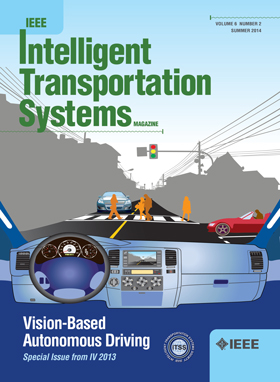Dual-STGAT: Dual Spatio-Temporal Graph Attention Networks With Feature Fusion for Pedestrian Crossing Intention Prediction
IF 7.9
1区 工程技术
Q1 ENGINEERING, CIVIL
IEEE Transactions on Intelligent Transportation Systems
Pub Date : 2025-02-13
DOI:10.1109/TITS.2025.3528391
引用次数: 0
Abstract
Pedestrian intent prediction is critical for autonomous driving, as accurately predicting crossing intentions helps prevent collisions and ensures the safety of both pedestrians and passengers. Recent research has focused on vision-based deep neural networks for this task, but challenges remain. First, current methods suffer from low efficiency in multi-feature fusion and unreliable predictions under challenging conditions. Additionally, real-time performance is essential in practical applications, so the efficiency of the algorithm is crucial. To address these issues, we propose a novel architecture, Dual-STGAT, which uses a dual-level spatio-temporal graph network to extract pedestrian pose and scene interaction features, reducing information loss and improving feature fusion efficiency. The model captures key features of pedestrian behavior and the surrounding environment through two modules: the Pedestrian Module and the Scene Module. The Pedestrian Module extracts pedestrian motion features using a spatio-temporal graph attention network, while the Scene Module models interactions between pedestrians and surrounding objects by integrating visual, semantic, and motion information through a graph network. Extensive experiments conducted on the PIE and JAAD datasets show that Dual-STGAT achieves over 90% accuracy in pedestrian crossing intention prediction, with inference latency close to 5ms, making it well-suited for large-scale production autonomous driving systems that demand both performance and computational efficiency.基于特征融合的双时空图注意网络行人过马路意向预测
行人意图预测对自动驾驶至关重要,因为准确预测交叉口意图有助于防止碰撞,确保行人和乘客的安全。最近的研究主要集中在基于视觉的深度神经网络上,但挑战仍然存在。首先,目前的方法存在多特征融合效率低、在复杂条件下预测不可靠等问题。此外,在实际应用中,实时性能是至关重要的,因此算法的效率至关重要。为了解决这些问题,我们提出了一种新的架构,Dual-STGAT,它使用双层时空图网络提取行人姿态和场景交互特征,减少信息损失,提高特征融合效率。该模型通过两个模块:行人模块和场景模块捕捉行人行为和周围环境的关键特征。行人模块使用时空图注意力网络提取行人的运动特征,场景模块通过图网络整合视觉、语义和运动信息,对行人与周围物体之间的相互作用进行建模。在PIE和JAAD数据集上进行的大量实验表明,Dual-STGAT在行人过马路意图预测方面的准确率超过90%,推理延迟接近5ms,非常适合对性能和计算效率都有要求的大规模生产自动驾驶系统。
本文章由计算机程序翻译,如有差异,请以英文原文为准。
求助全文
约1分钟内获得全文
求助全文
来源期刊

IEEE Transactions on Intelligent Transportation Systems
工程技术-工程:电子与电气
CiteScore
14.80
自引率
12.90%
发文量
1872
审稿时长
7.5 months
期刊介绍:
The theoretical, experimental and operational aspects of electrical and electronics engineering and information technologies as applied to Intelligent Transportation Systems (ITS). Intelligent Transportation Systems are defined as those systems utilizing synergistic technologies and systems engineering concepts to develop and improve transportation systems of all kinds. The scope of this interdisciplinary activity includes the promotion, consolidation and coordination of ITS technical activities among IEEE entities, and providing a focus for cooperative activities, both internally and externally.
 求助内容:
求助内容: 应助结果提醒方式:
应助结果提醒方式:


